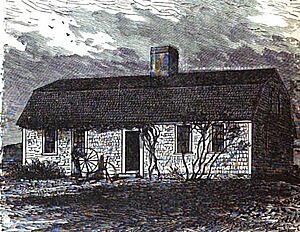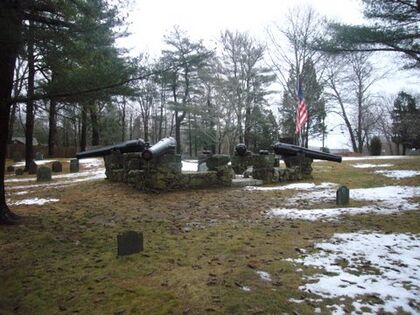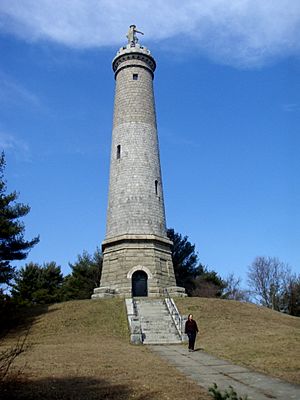Myles Standish facts for kids
Quick facts for kids
Myles Standish
|
|
|---|---|
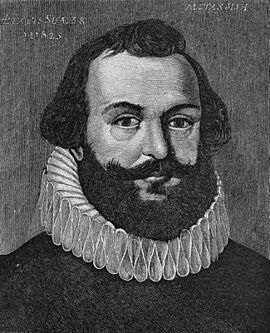
This portrait was first published in 1885 and alleged to be a 1625 likeness of Standish, although its authenticity has never been proven.
|
|
| Born | c. 1584 Probably within West Derby or Leyland Hundred, Lancashire, England |
| Died | October 3, 1656 (aged 72) Duxbury, Plymouth County, Plymouth Colony |
| Allegiance | England Plymouth Colony |
| Rank | Captain |
| Commands held | Plymouth Colony militia |
| Battles/wars | Eighty Years' War (Netherlands) Wessagusset Colony (Plymouth Colony) |
| Spouse(s) | Rose Standish Barbara Standish |
| Signature | |
Myles Standish (born around 1584 – died October 3, 1656) was an English military officer. He became a key leader in the early days of Plymouth Colony in what is now Massachusetts, United States. The Pilgrims hired Standish as their military advisor. He sailed with them on the famous ship Mayflower in 1620.
Standish played a very important role in protecting and managing Plymouth Colony from the start. In 1621, the colony's militia (citizen soldiers) chose him as their first commander. They re-elected him to this position for the rest of his life. He also served as an assistant governor and treasurer for the colony.
Standish was known for taking strong actions to protect the colony. He led several expeditions to resolve conflicts with some Native American groups. While his actions were sometimes seen as harsh by others in the colony, they were often effective in keeping the settlers safe.
Later in life, Standish became a farmer in Duxbury, Massachusetts, where he was one of the first settlers. He continued to advise the colony's military forces. He passed away in Duxbury in 1656 at the age of 72. Myles Standish dedicated much of his life to supporting and defending the Pilgrims' colony.
His story is remembered in many ways, including in the 1858 poem The Courtship of Miles Standish by Henry Wadsworth Longfellow. This poem helped make the Pilgrim story famous in American culture.
Contents
Myles Standish's Early Life and Military Career
Historians do not know much about where Myles Standish was born or his early life. His will, written in 1656, mentioned property in several places in Lancashire, England, and the Isle of Man. This suggests he might have been born in Lancashire, possibly near Chorley. However, there is no clear proof linking him to a specific family or place.
The earliest records about Standish's family say he was a gentleman from Lancashire. They also mention that he was supposed to inherit a large estate, but it was unfairly kept from him.
Military Service in the Netherlands
In his younger years, Standish went to the Low Countries (present-day Netherlands). At that time, the Dutch Republic was fighting the Eighty Years' War against Spain. England's Queen Elizabeth I of England supported the Dutch Protestants and sent troops to help them.
Standish likely served as a soldier during this war. Some historians believe he was a hired soldier, while others think he was an officer in the English army. He may have served under Sir Horatio Vere, a general who led English troops in the Netherlands. Standish might have fought in the siege of Sluis in 1604.
After 1609, Standish's activities are not recorded until 1620. By then, he was living in Leiden, Holland, with his wife Rose and was known as "Captain."
Joining the Pilgrims
In Leiden, a group of English Puritans, known as the Pilgrims, were planning to start a colony in North America. They hired Standish to be their military advisor. The Pilgrims had considered Captain John Smith, who had experience in the Jamestown, Virginia colony. However, Smith's price was too high, and they worried he might try to take too much control. They chose Standish instead, who was already known to them.
The Voyage to New Plymouth
On July 22, 1620, the first group of Pilgrims left Leiden on a ship called the Speedwell. Myles and Rose Standish were among them. The Speedwell sailed to Southampton, England, to meet a larger ship, the Mayflower. About 30 passengers were on the Speedwell, and 90 more would board the Mayflower.
The Speedwell had problems with leaks, causing many delays. After returning to port twice, the leaders decided to leave the smaller ship behind. The Standishes and most of the Speedwell passengers moved to the Mayflower.
The Mayflower finally left Plymouth, England, on September 6, 1620. Their goal was to reach the northern part of the Virginia Colony.
Landing at Cape Cod
On November 9, 1620, the lookouts spotted land. They realized they were near Cape Cod, about 200 miles northeast of their planned destination. They tried to sail south, but strong seas forced them back to Cape Cod, where they found shelter in Provincetown Harbor.
The bad weather made it too dangerous to continue south. They decided to settle near Cape Cod because they were running low on supplies. On November 11, they anchored, and the colony's leaders wrote the Mayflower Compact. This agreement helped establish laws and order in their new settlement. Myles Standish was one of the 41 men who signed it.
Establishing Plymouth Colony
While the Mayflower was anchored off Cape Cod, Standish encouraged the leaders to let him explore the land to find a good place for their settlement. On November 15, 1620, he led 16 men to explore the northern part of the Cape.
On December 11, he led a larger group of 18 men to explore the coast by boat. One night, they were attacked by about 30 Native Americans. The group panicked, but Standish calmly told them not to waste their musket shots. This event, which happened in Eastham, Massachusetts, became known as the First Encounter.
After more exploration, the Pilgrims chose a spot in Plymouth Bay in late December 1620 for their new home. Standish gave important advice on where to build a small fort for cannons and how to arrange the first houses for better defense.
The First Winter
The settlers had only built one house when a terrible illness spread through the colony. Out of about 100 people who arrived on the Mayflower, only 50 survived the first winter. Standish's wife, Rose, died in January.
Myles Standish was one of the few who did not get sick. William Bradford, who later became governor, said Standish comforted many people and was a source of strength. Standish cared for Bradford during his illness, starting a friendship that lasted for decades. Bradford and Standish were very different people: Bradford was patient, while Standish was known for his quick temper. Despite their differences, they worked well together to manage the colony and face dangers.
Resolving Conflicts with Native Americans
Myles Standish was elected as the leader of the Plymouth Colony militia in February 1621. He regularly trained the men to use their weapons, like pikes and muskets. This was important because the colonists had seen Native Americans nearby but had not yet communicated with them.
In March 1621, the Pilgrims met Massasoit, the leader of the nearby Pokanoket tribe, through an English-speaking Native American named Samoset. Governor John Carver signed a peace treaty with Massasoit. This treaty meant the Pokanokets and the colonists would help each other if needed. After Governor Carver died, William Bradford became governor and continued to uphold this treaty.
Bradford and Standish often worked together to respond to threats from other tribes, like the Massachusetts and Narragansetts. Standish often believed in using strong actions to prevent attacks. While Governor Bradford sometimes felt uneasy about these methods, he found them effective in keeping the peace with the Pokanokets.
The Nemasket Expedition
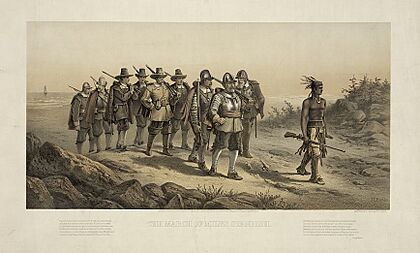
In August 1621, a leader named Corbitant tried to turn people against Massasoit in the Pokanoket village of Nemasket. Governor Bradford sent two trusted interpreters, Squanto and Hobbamock, to find out what was happening. Corbitant captured Squanto and threatened him. Hobbamock escaped and warned Plymouth.
Bradford and Standish decided this was a serious threat to their alliance with Massasoit. On August 14, 1621, Standish led 10 men to Nemasket. They were guided by Hobbamock, who became a close friend of Standish.
Standish planned a night approach to the shelter where Corbitant was thought to be. When they entered, there was confusion. Some Pokanokets tried to escape, and Standish's men fired their muskets, injuring a Pokanoket man and woman. These injured individuals were later taken to Plymouth for treatment. Standish soon learned that Corbitant had already left the village, and Squanto was safe.
Even though Corbitant was not captured, the expedition had a strong effect. On September 13, 1621, nine Native American leaders, including Corbitant, came to Plymouth. They signed a treaty showing their loyalty to King James.
Building Defenses
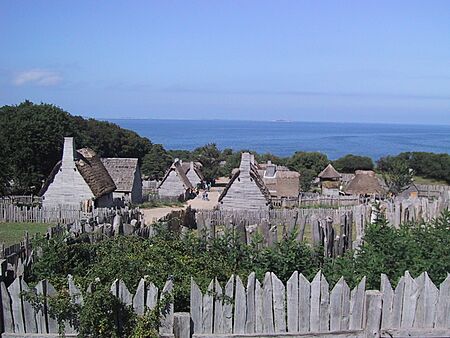
In November 1621, a messenger from the Narragansett tribe delivered a bundle of arrows wrapped in snakeskin. Squanto and Hobbamock explained this was a threat from the Narragansett leader Canonicus. Governor Bradford sent the snakeskin back filled with gunpowder and shot, showing they were not afraid.
Standish took this threat seriously. He urged the colonists to build a strong wall, called a palisade, around their village. This wall would be made of tall, upright logs and would be over half a mile long. He also suggested building strong gates and platforms for defense. Even though there were only about 50 men to work, they built the palisade in just three months. Standish then divided the militia into four groups and trained them to defend the village.
The Wessagusset Incident
A more serious threat came from the Massachusett tribe to the north. This happened after a new group of English colonists arrived in April 1622. These new settlers, sent by a merchant named Thomas Weston, started a colony called Wessagusset, about 25 miles north of Plymouth.
The Wessagusset settlers caused problems with the Massachusett tribe through their actions. By March 1623, Massasoit learned that some Massachusett warriors planned to attack both Wessagusset and Plymouth. He warned Plymouth to act first. A Wessagusset colonist named Phineas Pratt escaped to Plymouth and confirmed the danger. He reported that the Wessagusset settlers were constantly threatened and suffering from hunger.
Governor Bradford called a meeting, and the Pilgrims decided to send Standish with a small group of eight men, including Hobbamock, to Wessagusset. Their mission was to deal with the leaders of the plot. One of the warriors threatening Wessagusset was Wituwamat, who had previously insulted Standish.
When Standish arrived at Wessagusset, he found many colonists had left to live with the Massachusett tribe. He ordered them to return. Pecksuot, a Massachusett warrior and leader of the group threatening Wessagusset, came to the settlement with Wituwamat and other warriors. Standish pretended to be there for trading. Pecksuot, looking down on Standish, said, "You are a great captain, yet you are but a little man. Though I be no sachem, yet I am of great strength and courage."
The next day, Standish arranged to meet Pecksuot for a meal. Pecksuot brought Wituwamat, Wituwamat's younger brother, and several women. Standish had three men from Plymouth and Hobbamock with him. At a signal, they closed the door. Standish confronted Pecksuot and the other leaders of the plot. In the struggle that followed, these leaders were overcome. Standish then took further action to ensure the safety of the Wessagusset settlers.
After completing his mission, Standish returned to Plymouth. The leaders of the plot were no longer a threat, but these actions had unexpected results. The Wessagusset settlement was mostly abandoned, with many settlers leaving for another English fishing post. The attack also caused fear among Native American tribes in the region, and trade became difficult for a while.
Pastor John Robinson, who was still in Leiden, criticized Standish for his harsh methods. Governor Bradford also felt uneasy but defended Standish, saying he was a very helpful and dedicated leader for the colony.
Dealing with Merrymount Settlers
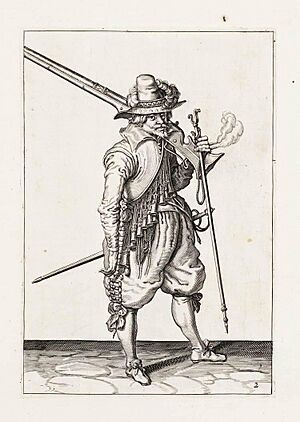
In 1625, another group of English settlers created an outpost called Mount Wollaston, nicknamed "Merrymount," near Quincy, Massachusetts. Their leader, Thomas Morton, encouraged activities that the Pilgrims found unacceptable and dangerous. The Merrymount settlers built a maypole, drank a lot, did not observe the Sabbath, and sold weapons to Native Americans.
Governor Bradford was especially worried about the weapons sales. In 1628, he ordered Standish to lead an expedition to arrest Morton. Standish arrived with his men to find the Merrymount group barricaded inside a small building. Morton eventually tried to attack the Plymouth men, but his group couldn't use their weapons properly. Standish disarmed Morton. Standish and his men took Morton to Plymouth and later sent him back to England. Morton later wrote a book where he called Standish "Captain Shrimp."
The Penobscot Expedition
Standish's last major expedition was against the French in 1635. The French had taken back a trading post on the Penobscot River in Castine, Maine, which English forces had captured earlier and given to Plymouth Colony. This post was important for furs and timber.
Governor Bradford wanted the post back. Standish led an expedition, chartering a ship called Good Hope. His plan was to use the ship's cannons to force the French to surrender. However, the ship's captain, Girling, fired the cannons too early, using up all the gunpowder before they were close enough. Standish had to give up the mission.
By this time, the larger Massachusetts Bay Colony had been established nearby. Bradford asked them for help to reclaim the trading post, but they refused. This showed the rivalry between Plymouth and Massachusetts Bay colonies. In 1691, these two colonies joined to become the royal Province of Massachusetts Bay.
Settling in Duxbury
In 1625, Plymouth Colony leaders sent Standish to London to negotiate new agreements with the Merchant Adventurers, who had funded the colony. If the Pilgrims could pay off their debt, they would gain new rights to divide land and settle freely. Standish was not successful on this trip. However, another effort in 1626, led by Isaac Allerton, succeeded. Several leading men of Plymouth, including Standish, eventually paid off the colony's debt.
Now free from the Merchant Adventurers' rules, the Plymouth Colony leaders organized a land division in 1627. Large farm plots were given to each family along the shores of Plymouth, Kingston, Duxbury, and Marshfield, Massachusetts. Standish received a 120-acre farm in Duxbury. He built a house and settled there around 1628.
By 1635, after the Penobscot expedition, Standish seemed to want a quieter life. He focused on his farm in Duxbury. He was about 51 years old and began to hand over military responsibilities to younger leaders. For example, in 1635, Lieutenant William Holmes was appointed to train the militia as Standish's second-in-command. When the Pequot War threatened in 1637, Standish was on a committee to raise soldiers, but Holmes led them in the field.
The families living in Duxbury asked to become a separate town with their own church. This request was granted in 1637. Historians believe Standish might have named Duxbury after Duxbury Hall, a manor near Chorley in Lancashire, owned by a branch of the Standish family.
Standish's Later Years
During the 1640s, Standish took on more administrative roles. He worked as a surveyor of highways and served as the colony's treasurer from 1644 to 1649. He also joined various committees to mark new town boundaries and inspect waterways. His old friend Hobbamock, who had lived with him, passed away in 1642 and was buried on Standish's farm.
Myles Standish died on October 3, 1656, at the age of 72. He was buried in Duxbury's Old Burying Ground, which is now called the Myles Standish Cemetery.
Family Life
Myles Standish was married twice:
- Rose (1601–1621): They married by 1618. Rose died during the first harsh winter in Plymouth. She was buried in an unmarked grave at Coles Hill Burial Ground. Her name is on the Pilgrim Memorial Tomb on Cole's Hill.
- Barbara: They married by 1624. Barbara arrived in Plymouth in 1623 on the ship Anne. They had seven children together. She died after October 6, 1659, and her burial place is unknown.
Children of Myles and Barbara Standish:
- Charles (1): Born in 1624, he died young between 1627 and 1635.
- Alexander: Born around 1626, he died on July 6, 1702. He was buried in Myles Standish Burying Ground. He married Sarah Alden (daughter of Mayflower passenger John Alden) by 1660 and had eight children. After Sarah died, he married Desire (Doty) (Sherman) Holmes by 1689 and had three more children.
- John: Born around 1627. There are no further records of him.
- Myles: Born around 1629, he died at sea after March 20, 1661. He married Sarah Winslow in 1660, but there are no records of children.
- Loara (Lora): Born on May 22, 1627, she died by March 7, 1655. She married Abraham Samson in 1646 and had seven children.
- Josiah: Born around 1633, he died in Preston, Connecticut, on March 19, 1690. He married Mary Dingley in 1654, who died in 1655. He then married Sarah Allen after 1655 and had eight children.
- Charles (2): Born around 1635, he was still alive in March 1655/1656. There are no further records of him.
Legacy and Remembrance
Myles Standish's real role in defending Plymouth Colony was often overshadowed by the fictional character in Henry Wadsworth Longfellow's poem The Courtship of Miles Standish. This poem, published in 1858, presented Standish as a shy romantic, which was not how he was in real life. Historian Tudor Jenks called the poem a "pleasant little fairystory" that was misleading about the people and events in old Plymouth. However, the poem made Standish a popular hero in 19th-century America.
In the late 1800s, the poem inspired a movement in Duxbury to build monuments to Standish. This also helped increase tourism to the town.
Monuments and Memorials
The largest monument, the Myles Standish Monument in Duxbury, began construction in 1872. It was finished in 1898 and is one of the tallest monuments to an individual in the United States. It stands 116 feet tall, with a 14-foot statue of Standish at the very top.
A smaller monument was placed over Standish's supposed grave in 1893. His remains were moved into a sealed chamber beneath this monument in 1930. His burial site is in the Myles Standish Burial Ground in Duxbury.
The original site of Standish's house is now a small park in Duxbury. Many places have been named after him, including Standish, Maine, and a neighborhood in Standish, Minneapolis. Two forts, one in Plymouth and a larger one in Boston Harbor, were also named in his honor. Camp Myles Standish in Taunton also bears his name.
The Myles Standish State Forest is a large public recreation area in southeastern Massachusetts. It is managed by the Department of Conservation and Recreation. Myles Standish Hall at Boston University was originally a hotel built in 1925. In 2024, Boston University removed Standish's name from the building, citing his harsh actions.
In 2020, Chorley in Lancashire planned events to commemorate 400 years since Myles Standish's Pilgrim journey. However, many of these plans were postponed due to the COVID-19 outbreak.
Images for kids
-
The Mayflower Compact, a painting by Jean Leon Gerome Ferris
-
Sir Horatio Vere was the commander of English troops in the Netherlands during the siege of Sluis in 1604, under whom Standish likely served.


